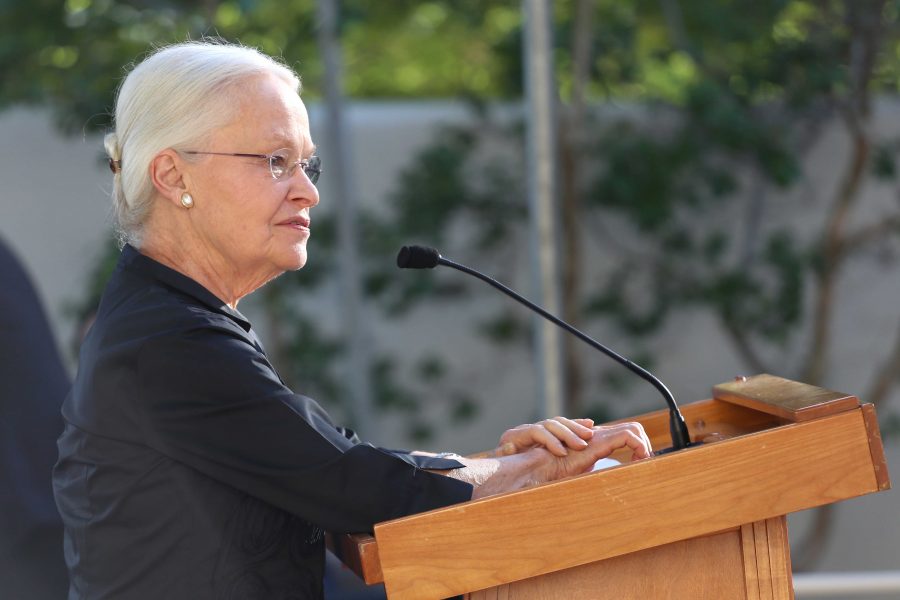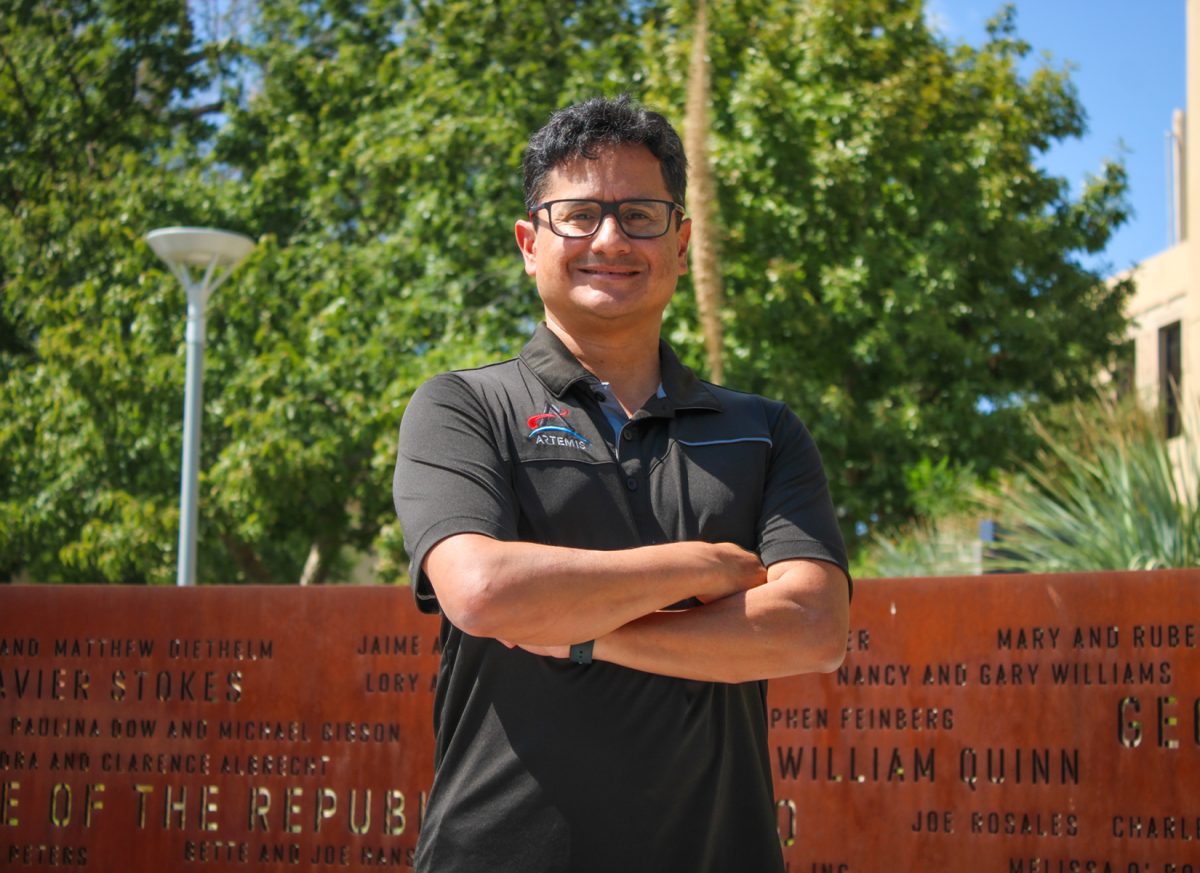After a storied 30-year tenure, UTEP President Diana Natalicio has announced her retirement on Tuesday morning, May 22, according to the university.
She plans on retiring as soon as a successor is appointed and assumes the office, according to a release sent by the university. Natalicio will address the media this afternoon at 2:30 p.m. in the President’s Conference Room, Administration Building, fifth floor.
During her 45 years at UTEP and prior to being named president of the university in 1988, she served as vice president for academic affairs, dean of liberal arts, chair of the modern languages department and professor of linguistics. During her presidency, the school’s enrollment has seen a substantial increase, from 15,000 to over 25,000 undergraduate and graduate students. Some of the budget increases can be traced back to her early pushes for more research, seeing a $65 million to nearly $450 million annual increase.
In 2016, Natalicio was named one of TIME 100 list of most influential people in the world and named in Fortune magazine’s 2017 Top 50 World Leaders. She has been honored by the Carnegie Corporation of New York in 2015, recognized by the President of Mexico in 2011, inducted into the Texas Women’s Hall of Fame and awarded doctoral degrees by St. Louis University, Northeastern University, Victoria University (Melbourne, Australia), Georgetown University, Smith College and the Universidad Autónoma de Nuevo Leon (Mexico).
She served on nationwide boards, including the Hispanic Scholarship Fund (HSF), Rockefeller Foundation, Trinity Industries, Sandia Corporation, U.S.-Mexico Foundation for Science (FUMEC), American Council on Education, National Action Council for Minorities in Engineering (NACME), Association of Public and Land-grant Universities (APLU) and Internet2. She was appointed by then-President George H.W. Bush to membership on the Advisory Commission on Educational Excellence for Hispanic Americans and by President Bill Clinton to the National Science Board, where she served two six-year terms, including three two-year terms as NSB vice-chair.
She told The Prospector last month, “In a role like this, you can make things happen. I never thought it would be 45 years, they’ve flown by like that.”
She sent out an email message regarding her retirement:
With the recent commemoration of two major milestones in my long and very happy relationship with The University of Texas at El Paso—45 years as a faculty member and 30 years as UTEP’s president—I have concluded that this may be an appropriate time to begin bringing to a close this chapter in my higher education story, nearly all of which I have joyfully spent at UTEP. I am therefore announcing today my plans to retire as UTEP’s president once a successor has been officially appointed and assumed the position. To be absolutely clear, this is not a farewell message to you, but rather an early alert about my plans.
Although approaching retirement saddens me—I am as energized today by UTEP’s many assets and future potential as I was 30 years ago!—I’ve always known that this day would inevitably come. Happily, it comes at a time when I have confidence that we will remain true to our core values and continue without interruption the transformative work that has been underway on this campus for the past 30 years.
To that end, we have been very actively engaged, and have already made significant progress, in executing a strategic administrative succession plan. We are immensely proud of the caliber of candidates for the administrative positions we have recently filled—vice presidents, deans and department chairs, athletic director and coaches. Their desire to join the UTEP family strongly validates our enhanced national stature as a public research university that is successfully achieving a highly innovative access and excellence mission.
As we have navigated the challenging issues facing higher education in the 21st century, UTEP has succeeded in fulfilling a promise that most other universities consider impossible: balancing equal and intersecting commitments to both access and excellence. UTEP has received national recognition as a public research university that has been extraordinarily successful at promoting student social mobility, while simultaneously building a reputation for excellence through our externally funded research competitiveness and the development of doctoral program quality across all colleges on the campus. We are very proud of our success in repositioning UTEP on the national higher education landscape, and especially proud to have successfully done so while never defaulting on our core commitment to ensure that all talented young people who entrust us with their aspirations will have an authentic opportunity to achieve them, regardless of their backgrounds or financial means.
To be sure, our work is not done, and many future challenges await UTEP and the students we serve, as the higher education ecosystem continues to change. I will save my reflections on those challenges for another time.
Instead, first and foremost, I want to express appreciation to our UTEP students whose success—on our campus and as alumni—has strongly validated our sustained confidence and investment in them. It has also been a privilege to work with faculty and staff members across the campus, whose expertise and creativity have ensured the rigor and competitiveness of UTEP’s educational programs and served generations of UTEP students exceedingly well. I thank these esteemed colleagues for their deep understanding, their courage, and their unwavering resolve to embrace fully, and work tirelessly, to achieve UTEP’s innovative higher education vision and our mission to deliver on our commitments to both access and excellence for students in this region and beyond.
Finally, I want to assure everyone—students, faculty and staff on the campus, our proud UTEP alumni, and our friends and partners in the surrounding community—that I will continue to support efforts to fulfill the extraordinarily deep commitment we have all made to be the best UTEP we can possibly be. We do that by serving this U.S.-Mexico border region as an exemplary public research university: creating authentic and exceptional educational opportunities for the region’s historically underserved population; conducting innovative research, scholarship and creative activity; and fostering the surrounding region’s prosperity and quality of life. Together, we have earned well-deserved national recognition for the success of the transformative work we have done over the past 30 years. I am confident that, during the forthcoming leadership transition and well beyond, we will continue to build on this strong foundation, working together to ensure UTEP’s competitiveness as a model public research university, while continuing to honor our core mission to promote educational opportunities and social mobility for all talented and hard-working students, especially those in this U.S.-Mexico border region, for whose future life pathways we have clear responsibility.
Go Miners!













